Indian literature does not have the past as a foreign land; instead, it exists within the very intimate confines of the present, influencing identities, narratives, and geography. Memory, from classical epics to modern novels, does not only serve as a theme but a living force—one inscribed into the walls of houses, ruins, cities, and minds. […]Read More
In the vast and intricate pantheon of Vedic mythology, numerous deities and celestial beings occupy roles that shape cosmic order, human destiny, and divine craftsmanship. Among these, the Ribhus stand out as a trio of divine artisans, renowned for their unparalleled skill and ingenuity. Unlike the more widely recognized deities such as Indra, Agni, or […]Read More
Hindu mythology is an intricate web of deities, symbols, and esoteric concepts that transcend time and geography. Among the many enigmatic figures within the Vedic and post-Vedic traditions is Aja Ekapada, a one-footed god shrouded in mystery and associated with Rudra, storms, and cosmic forces. Unlike more commonly known deities such as Indra, Vishnu, or […]Read More
Bhaga is a lesser-known but significant deity in the early Vedic pantheon, primarily associated with wealth, prosperity, and good fortune. He was once worshipped alongside Surya, the Sun God, and was considered one of the Adityas—celestial deities in Hinduism. His role in early Hindu thought, particularly in the Rigveda, highlights his importance as a distributor […]Read More
Manjusha Art, also known as Angika Art, is a traditional and vibrant folk art form that originated in the Bhagalpur region of Bihar, India. Deeply rooted in the cultural and religious history of the region, Manjusha Art has been cherished for its distinctive style, rich storytelling, and religious significance. This article delves into the origins, […]Read More
Gond tribal painting is a vibrant and intricate form of indigenous art that originated in Madhya Pradesh, India. It is deeply rooted in the cultural and spiritual traditions of the Gond community, one of the largest tribal groups in India. Traditionally, these paintings were created for rituals, festivals, and religious practices, adorning walls, floors, and […]Read More
Sikki art, a unique and intricate craft form originating from Bihar, is a testament to the region’s rich artistic heritage. Made from the golden-hued sikki grass, this art form has been practiced for centuries, traditionally depicting folklore, mythology, and scenes from nature. Once an integral part of everyday life and cultural expressions, sikki art has […]Read More
Panchmura, a small village in the Bankura district of West Bengal, is renowned for its exquisite terracotta art. While the village is widely recognized for its traditional Bankura horses, its unique terracotta paintings—once an integral part of temple murals and architectural decoration—are now a fading tradition. The distinctive style of Panchmura terracotta painting, characterized by […]Read More
India has a rich tradition of folk and tribal art, each form reflecting the unique cultural and spiritual values of the communities that practice it. Among these, Jadupatua painting stands out as a mystical and rare art form practiced by the Santhal and Jadupatua communities in Jharkhand. Characterized by its scroll format and deeply symbolic […]Read More
Mata ni Pachedi is a unique and ancient form of sacred cloth painting originating from Gujarat, India. Literally meaning “behind the Mother Goddess,” this traditional art form serves as a portable shrine for devotees who do not have access to temples. Created primarily by the Vaghari community, these hand-painted textiles are deeply intertwined with the […]Read More









